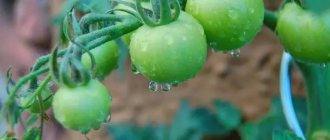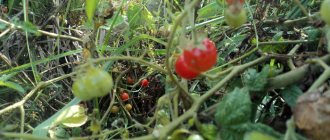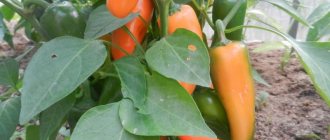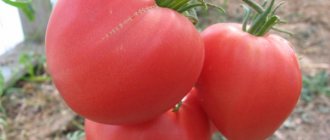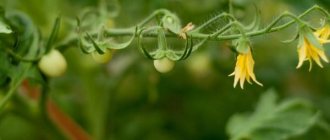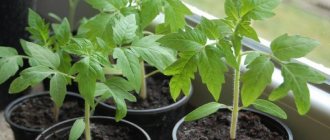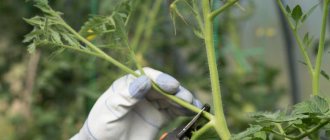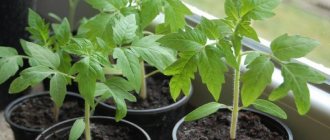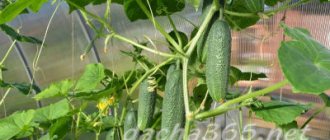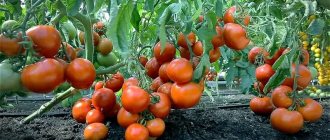Why do this work?
Stepsoning means removing unnecessary shoots (stepchildren) emerging from the axils of tomato leaves.
Removing a side shoot manually
Productivity depends more on the availability of light and nutrients than on the number of flowers and stems.
The appearance of the ovary and its maturation occur with good lighting and air exchange. If you do not cut off the useless shoots, the minerals will go to the growth of green mass, and the tomatoes will be tasteless and small.
What is pinching tomatoes and why should it be done?
In their natural habitat, tomatoes are perennial crops, in which, during development, the bush begins to branch quite actively. This vegetable crop grows freely only in Mexico with its endless and warm summers. Tomatoes spend the first 3-4 months developing roots, gaining green mass, and only after that they begin to form buds.
In the hot Mexican climate, tomatoes have an endless warm period. They have nowhere to rush. Over time, inflorescences form on each shoot, so tomatoes do not require pinching under natural growing conditions.
With such a short gardening season as in Russia, loyalty to the vegetable will lead to the events described above - you will get a decorative, but very beautiful flowering bush.
As the plant grows, side shoots appear from the axils of its leaves, which are considered stupid. In addition to their complete stupidity, they also take away nutrients from the fruits themselves, preventing them from growing and developing.
The appearance of these branches causes the bush to actively grow. For every useful branch, where the fruit will later be formed, as a rule, there are more than 6 useless ones.
These lateral branches are called “stepson”. As the bush develops, it is customary to remove them. This process is called stepsoning.
Pinching is a special agrotechnical procedure in vegetable growing aimed at increasing productivity. Pinching is necessary for optimal development of the bush through its correct formation.
Thus, after removing excess branches, only fruit-bearing ones remain on the bush, which allows for more efficient and targeted use of applied fertilizers and nutrients from the soil.
Particularly many unnecessary side shoots are formed on tall varieties, in which a branch with tomatoes is formed only in the area of 7-11 leaves.
How to choose the time?
Formation begins as soon as the seedlings adapt after planting in the ground. The shoots are removed in the morning of a clear day, when the greenery is lush and no rain is expected. Excess branches break off easily, wounds heal quickly. Then the sections are processed, sprinkled with ash or crushed coal.
Inspect the plants weekly, immediately eliminating emerging shoots before they turn into thick stems. In this case, cutting them off injures the mother bush. It may weaken and yields will decrease.
This work is carried out throughout the summer until autumn. Then the fruits will be large and the harvest will be high.
When to plant tomatoes
The main rule of a fighter with stepchildren is the correct choice of time and procedure.
The very first pinching is carried out 14 days after planting the seedlings in the ground, as soon as the flowers in the lower cluster open. After the first stepsoning, this operation will need to be repeated regularly - every 10-14 days.
This period was not chosen by chance. It will allow you not to miss all the newly growing shoots, and will prevent the bush from thickening.
It is important to remember that in reality, the timing of stepsoning may be blurred. Some vegetable growers carry out this operation already when they are gartering tomatoes.
For pinching, choose a warm, clear day, and do the procedure in the morning, so that by the evening the wounds from pruning or breaking off have time to heal.
The most optimal time is from 9 to 11 o'clock.
Difference between a side shoot and a peduncle
IMPORTANT . You need to know the difference between a stepson and a peduncle. The first grows from the axil between the leaf blade, the main trunk. The beginning of useful formations occurs on the trunk.
Even the smallest stepsons have leaves. There are only flower buds on the fruit bearing.
Stepson of tomato
Kinds
There are three ways to form:
One stem
All useless branches are deleted. The main core remains - for the fruit bearings. It must be tied up, otherwise it will break under the weight of vegetables.
Two stems
On the bush, under the very first inflorescence, a strong shoot remains. The rest break off.
Three stems
In addition to the main one, two strong stems are preserved next to the lower flower raceme.
ATTENTION . Under a film coating, pinching is usually carried out using the first two methods. In open ground - any of the three. Depends on the species.
Types of pinching
Features of growing low-growing tomatoes
Low-growing tomatoes, or determinate ones, are loved for their early ripening, they produce few offspring and ripen together. The planting of low-growing tomatoes takes place in 2 or 3 stems. This improves the quality and quantity of fruits. The less nutrients are spent on the leaves, the more will go into the fruits.
With a large number of shoots and leaves, it is difficult to harvest without damaging the plants. You end up with real thickets that you have to wade through.
Also, don’t forget about tying up the tomatoes. With good care, the fruits turn out to be quite heavy and can break off a branch. This will lead to injury to the plant and, as a result, deterioration in fruiting.
The exception is standard tomatoes with a height of 40-60 cm and a thick stem. Such plants are even grown on the windowsill.
There are many varieties of low-growing tomatoes that do not require pinching. Such plants have excellent resistance to low temperatures. If you grow them without seedlings, that is, plant them directly in open ground, they will be hardened and stress-resistant.
Low-growing tomatoes are suitable for novice vegetable growers or people who, due to their workload, cannot devote much time to the formation of plants.
Reference . Low-growing, non-sprouting tomatoes are practically not susceptible to late blight. This disease most often affects plants at the end of August. By that time, low-growing tomatoes almost stop bearing fruit.
How to stepchildren different types of growth
There are several groups of tomatoes, distinguished by growth type:
- Indeterminate , or climbing. Tall tomatoes can reach 5 meters or more, their growth is not limited. They bear fruit for a long time - more than 4 months. Their vines are subject to mandatory pinching. Moreover, they lead only one main vine, sometimes two.
- Semi-determinant . Tall tomatoes. Up to 10-12 brushes are formed on them. The development of the main branch (up to 180 cm) can stop at any time. When it will happen is impossible to predict.
- Determinate varieties/hybrids. Medium height (growth limited). After the formation of several inflorescences, the growth point on the main stem freezes.
- Standard - low-growing (about 60 cm) tomatoes. They have a compact root system. The powerful rod resembles a tree trunk - a standard. Hence the name of the species.
Growing indeterminate varieties
Growing indeterminate tomatoes
These species in the northern regions are grown only under film cover, in the southern regions - both in open ground and protected.
In this crop, unnecessary branches grow from all the axils, turning the plantings into impenetrable thickets.
When they are formed, there are two branches in the south, and one in the north.
When shaping with one rod, all lateral processes should be removed. Leave no more than 10 fruit bearings. Break off the excess ones.
If the formation takes place with two trunks, the second is created under the lower fruit cluster. There should be 5 fruit bearings left on it. Delete others.
Semi-determinant
They are formed from two or three stems.
Peculiarity! Development may stop after several fruiting branches appear. For such a case, spare branches are left. If the seedling stops growing, a reserve stepson is formed like the first. This technique saves the product.
In case of sudden cessation of development, it is recommended to leave 2 lateral branches at the top for additional fruit production.
How to plant determinate varieties
Seedling of determinate tomatoes
Up to 4-6 peduncles are formed on the trunk. Development stops with the last inflorescence at the top.
Stepchildren are pruned moderately or not pruned at all. In the first case, up to 4 branches are left, which can later be used to produce additional vegetables.
Remove excess branches in a special way.
The first shoot should remain under the lower inflorescence. Then a second trunk is made from it.
Then the shoot remains under the third inflorescence. It is also converted to a new branch.
When the fourth hand appears, the stepson is also allowed to develop under it.
If development continues, the reserve branches are removed.
Standard tomatoes
This crop grows with one trunk. Branches appear late and do not interfere with the development of the mother plant.
On such a vegetable, twigs from the lower sinuses (up to 4 pieces) are initially left. They are usually powerful, like the main rod. Good increase in yield.
The shoots that appear higher are broken off without waiting for them to be pulled out, or are not touched.
How to distinguish a stepson from a fruit cluster
What is a stepson? This is a future side branch. As it grows, it will give:
- stem;
- leaves;
- flowers;
- fruit.
The difference between a stepson and a fruit raceme is that it always grows from the base of the leaf. You can't feel sorry for your stepsons. With a large number of them, the harvest will be small. An abundance of greenery is especially harmful for large-fruited varieties.
Features, step-by-step instructions
Peculiarities:
- Stepping up is a must to get rid of unnecessary formations
- If this is not done, the tops will grow. This will worsen the ventilation of seedlings and provoke diseases.
- Their quality will deteriorate and tying will slow down.
Eliminating excess branches will improve the nutrition and development of tomatoes. It solves the following problems:
- Controls the growth of green mass
- Directs nutrients to accelerate the ripening of ovaries
- Provides seedlings with good ventilation
- Provides the right lighting
- Protects against diseases and insects
When breaking out side shoots, you should clarify which species is being processed. For each of them there are features of this procedure.
Breaking out side shoots
We need to pay attention to the following points:
Low-growing tomatoes run the risk of removing the tops on which future fruits should grow. Therefore, if in doubt, it is better to pinch such a process later.
The top is removed after the appearance of the fifth or sixth inflorescence.
In tall ones , a mass of branches is formed. If two main branches are formed, it is necessary to regulate the number of peduncles on them.
Medium-sized ones can be formed by two or three main branches. Sometimes, after the elimination of unnecessary formations, development stops. For such cases, it is necessary to leave up to two reserve branches that can replace the top.
Step-by-step instruction
- The elimination of side shoots begins 13 days after the seedlings are planted in a permanent place.
- The shoots are cut off when their size is no more than 6 cm
- When in doubt: a branch or a peduncle, you need to look at where it is growing from. If it comes from the axil and has leaves on it, it is an unnecessary formation that must be destroyed.
- Excess branches are broken off by hand or with sharp scissors or pruning shears. Tools must be disinfected before starting work and each time you move to the next bush.
Attention! To prevent new branches from growing in place of the removed ones, it is necessary to leave stumps 1.8 cm thick.
- The procedure is carried out in the morning.
- Watering should be done the night before. Then the stepsoning will be painless.
- Excess formations are removed: in open ground - every 11 days, under film cover - every 7 days.
- In regions where summers are short, all unnecessary branches are destroyed to ensure rapid ripening.
- Leaves in contact with the soil and shading the fruiting plants must also be disposed of.
- After the procedure, the plants must be given time to recover, and then watered and fertilized.
The benefits of pinching
- Fruit ripening occurs 2 weeks earlier;
- you get more ripe tomatoes by the end of the season;
- tomatoes grow to large sizes;
- the likelihood of contracting infections is reduced, as the bush itself becomes less dense;
- tomatoes get more sunlight;
- sugars accumulate in the pulp in greater quantities.
To achieve the desired result, the bush formation procedure must be carried out competently and systematically.
Let's look at the operation in more detail. Below are step-by-step instructions, formation schemes, features of working with different varieties, approaches to the procedure in a greenhouse and on open ground.
What is pinching?
Pinching tomatoes
This is the removal of the top of the tomato plant, its growing point. The procedure is especially important for tall crops.
Goals:
- Stop the growth of the bush so that the forces are directed towards obtaining a good harvest
- Strengthen the root system
- Improve the quality of tomatoes
- Accelerate ripening
- Ensure good lighting, ventilation, and complete supply of minerals to the fruits
- Avoid getting misshapen vegetables
The average pinching period is the end of July, until August 4.
Carrying out work in the greenhouse
In a greenhouse, vegetables are grown in more favorable conditions. Therefore, the removal of side branches has some peculiarities.
Reasons for the features:
- Seedlings are grown and planted early. Fruiting occurs faster
- Due to limited space, bushes are placed tightly. Therefore, gardeners prefer tall crops.
- Greenhouse conditions contribute not only to increased yields, but also to a longer fruiting period.
For these reasons, the breaking off of stepchildren is carried out earlier and more often than in a regular garden bed.
A seedling is formed by one trunk. All unnecessary branches are cut off.
To obtain an early harvest, greenhouse determinate tomatoes can be grown with two stems. In this case, a side shoot is left under the lower flower raceme. When the first peduncle appears on the branch, it must be pinched.
In addition, it is necessary to pick off yellowed, dried leaves.
Excess formations are broken off weekly. If they are allowed to grow long, they will be difficult to spot among foliage and other stems.
Important! Culture doesn't like heat. Therefore, the room must be ventilated regularly (at least 2 times a week or as needed).
Choosing the right scheme for a greenhouse and an open bed
Growing tomatoes in a greenhouse, as a rule, is carried out according to the 1st and 2nd schemes, since a 3-flowered bush is rarely formed in them. On open ground, the procedure can be carried out using any option, depending on the variety of tomatoes.
If we consider the pinching technology itself for a greenhouse and an open bed, then they have no differences. The first operation is carried out when buds appear, until the side shoots have grown more than 5 centimeters. With a larger size of the removed shoot, the likelihood of disease in the tomato bush increases. Then we carry out the procedure every 10-14 days.
Removing foliage
Why cut off
The average lifespan of leaves is 3 months. Afterwards they dry out, die, and become a burden. The process begins with the lower sheet plates. They will definitely be cut off.
The next reason for this operation is the large green mass.
It takes away nutrients. Vegetables grow small, tasteless, and take a long time to ripen.
Reference! The harvest will be saved by removing the leaf blades from below. This creates conditions for the appearance of inflorescences, ovaries and their maturation.
There is also a reason for this procedure: the leaves have contact with the soil. This can cause fungal diseases.
All leaves that are located below the first peduncle with ovaries are torn off.
The risk of contracting diseases from contact with the ground is reduced several times.
Trimming tomato foliage
In addition, moisture loss is reduced. Improves ventilation of tomatoes.
Such actions are especially important for the greenhouse.
You need to get rid of all yellow, drying leaves.
Leaves that create shade for ripening ovaries are useless.
How to remove it correctly?
Rules:
- To ensure that the wounds heal quickly, the operation is performed in the morning on a sunny day.
- You cannot pick off a large amount at the same time.
- There is no need to rush into breaking out the bottom plates.
- The torn material is burned.
This operation should begin after 9-15 days after the seedlings were planted.
First, yellowed and brown spots are removed. Then - healthy ones, located near the ground, thickening the crown. This has a positive effect on the appearance of new inflorescences.
The next stage is the period of ovary maturation. It is necessary to tear off the plates located under the first fruiting cluster, and part of the foliage that creates shade for the ripening tomatoes.
Carefully! If there is a danger of sunburn, protection should remain.
Leaf plates can be either broken off or trimmed.
In order for the petiole to break off easily, you need to pull it up. To disinfect the wound, sprinkle it with ash or soda.
If pruning is done with scissors or pruning shears, they must be dipped into a strong solution of potassium permanganate or soda each time you move to a new plant.
What to do if the stepsons of tomatoes are overgrown?
Well, that happens. During the next audit, you missed the developing unplanned stepson, and a week later it has already outgrown and looks more like a full-fledged stem. What to do? You have 2 options:
- Cut off the stepson with a sharp knife or pruning shears, cover the wound with ash. The wound will be large, you need to act carefully. It is better not to remove other stepsons from the plant on this day.
- Leave the stepson. In principle, nothing bad will happen if you grow a plant with more stems than you expected. As a last resort, after a flower cluster has formed on the stepson, you can pinch it painlessly. That's all. The bush will continue to develop according to your planned pattern + one additional brush.
Can knives or scissors be used?
You can use scissors or a knife to remove excess branches.
Removing foliage with scissors
Certain rules must be followed:
- The sharpness of the blades should be razor-like so as not to cause major damage when cutting
- You need to cut accurately and quickly so as not to injure other parts of the plant.
Carefully! When moving to another bush, the blades should be disinfected in a solution of manganese (1%) or bleach (1%)
Experienced gardeners recommend that it is better not to cut off unnecessary formations, but to break them off. In this case, you need to make sure that the juice does not get on your fingers.
Forming a tomato bush with 1, 2, 3 stems: how to do it?
Bushes of this crop can be formed into 1 or several stems. What quantity to choose is up to you, but here you need to take into account the characteristics of the culture, your climate and the condition of the plant during the planting period.
- In 1 stem, crop varieties are most often formed that are characterized by unlimited growth - indeterminate varieties.
Indeterminate varieties of tomatoes
Formation of a bush of indeterminate varieties of tomatoes
- It is worth noting that forming a bush with 1 stem is the simplest and is perfect for beginning gardeners. With this formation, only the main trunk needs to be left; all secondary shoots must be mercilessly removed
- Sometimes it is recommended, even when forming a bush with 1 stem, to leave 1 brush on the first stepson, but then you will need to remove all emerging stepsons.
- At the same time, pay attention to removing the lower leaves of the crop. As soon as fully formed green fruits appear on the bush, remove all the leaves underneath them. But remember, you can tear off 2-3 leaves in one procedure, otherwise the plant will stop growing and the harvest will be lost.
As for the formation of a bush with several stems, it is more difficult:
- If we form a bush with 2 stems, in addition to 1 main stem, we will have 1 more, which will come from the stepson. In this case, you need to leave 1 strongest and healthiest stepson, who will then be able to please you with a rich harvest. Such a shoot is the stepson that grows under the first flower cluster - it is this that will need to be left.
- This shoot must be tied up and then cared for as the main stem. Further, unnecessary shoots will also appear on the bush, and they will need to be removed. It is recommended to carry out the procedure approximately once a week, and you need to monitor the size of the additional branches, it should not exceed 5 cm.
Forming a tomato bush with 1, 2, 3 stems
- As for the formation of a bush with 3 stems, it occurs in almost the same way as the formation of 2 stems. The only difference is that in addition to the main shoot, we will leave 2 more stepsons. We leave the 2 lowest shoots and grow them as full-fledged shoots. In this case, it is recommended to tie the stepsons to the supports.
- The remaining shoots will need to be removed.
Advantages and disadvantages
Removal of unnecessary formations is carried out both to increase the yield, obtain large fruits, and to prevent diseases.
Densified plantings and high humidity (especially important for greenhouses) are good conditions for late blight disease.
pros:
- Improves lighting and ventilation of seedlings
- Increased collection of large fruits
- Reduces the risk of fungal diseases
- Makes maintenance easier
- A rare species can be propagated using stepchildren
Minuses:
- Possibility of transmitting diseases due to poorly disinfected instruments
- If there is an error in choosing a stepchild, part of the product is lost
- New branches may grow in place of removed branches. I have to break it off again.
Tips and tricks
To ensure the best care for your tomatoes, carefully read the instructions on the seed package. Buy products from reputable and trusted manufacturers.
Water the tomatoes “at the root” - do not pour water on the leaves. In hot weather they will get burned, in cloudy weather the risk of late blight will increase.
It is best to make a small depression not far from the trunk or organize drip irrigation: this way the roots will not be damaged. Organize regular ventilation in greenhouses. Thanks to this, the plants will be pollinated, and the risk of becoming infected with late blight will be reduced.
Use only warm water. Otherwise, the plants will get sick.
In what cases do plants not take stepson?
Low-growing varieties of tomatoes do not shoot.
Indeterminate varieties especially need removal of unnecessary shoots. Such an operation is not necessary for low-growing or hybrid seedlings.
Features of low-growing varieties:
- Short
- Productive
- Moderate green mass
- The ovaries develop together, simultaneously
- All are the same size
Advantages of low-growing varieties:
- Cold resistance. They do not have to be planted in a greenhouse. Some seeds can be sown directly into the garden bed, covered with film.
- Maintenance is simple: no need to track new branches, no need to tie up
- The harvest is high. More nutrition goes to the fruits than to the green mass.
- Ripening time is early (85-110 days)
- Does not require careful soil selection
- Have a neat appearance
Attention! Fresh manure should not be used for fertilization. The branching of bushes will increase
Popular non-stepping species
Among the varieties for open ground:
"Moskvich"
The best, resistant to cold, temperature changes, late blight and other diseases.
The ripening period from the beginning of germination is 90 – 100 days. There are 6 tomatoes per bunch.
Productivity – up to 10-14 kg per square meter.
"Fighter"
Siberian variety, resistant to low temperatures and droughts. Good for northern regions.
Ripening begins on the 98th day from the start of germination. The total weight per square meter is about 25 kg.
"Snowdrop"
Excellent cold resistance. Excellent for Karelia, the Urals and other cold regions.
In warm areas, sowing is done directly into the garden bed.
Group of varieties "Gnome"
Lives up to its name. Height 45-50 cm, less often they grow up to 130 cm. Maturing period: from emergence 86-109 days. Resistant to diseases. From the plant you can harvest over 3 kg of tomatoes (weighing up to 150 and even 300 grams) with excellent transportability and long shelf life.
Among the varieties for protected soil:
"Nevsky"
The earliest variety of the entire crop. Ripening can begin on the 70th day from seed germination.
Weighing up to 60 grams. Sow directly into the garden bed and cover with film. Grows well in any climate.
Reference! It is necessary to feed well during the growing season.
"Watercolor"
Reminds me of a bull's heart. Absolutely do not need stepsoning. Ripening period is 95-100 days. Tomato weight is 85-120 grams. Transportable and stored for a long time.
"Amber"
Height - up to 36 cm. Very early. It begins to sing 81 days after the appearance of the first sprout. The color is bright, yellow. Weighing 46-70 grams.
Productivity up to 7 kg per square meter. m. Late blight and macrosporiosis are not afraid.
Hybrid "Vityaz"
Very suitable for small greenhouses.
Peculiarity! With a height of up to 75 cm, the average weight is 130 grams. Therefore, a mandatory garter is required.
Stepping depending on the variety
The basic principles of pinching apply to all tomatoes. But the choice of formation scheme, frequency of procedures, and the need for pinching depend on the specific variety.
Plants branch with different intensity and grow green mass in different ways.
Indeterminate
The stems of such tomatoes grow throughout the growing season; by the end of the season, some of them can reach a height of 4-6 meters.
Indeterminate varieties tend to produce many side shoots. In most cases, a flowering raceme is formed at the level of 7-11 leaves, therefore, for each there are 6-10 barren branches.
Indeterminate tomatoes in most regions of Russia are cultivated only in greenhouses, but in the southern regions they are also grown in open ground.
For such varieties, pinching is mandatory. Usually one stem is left, but any formation of bushes is allowed if the distance between them allows them to avoid thickening. Leave 5-10 clusters on the stem.
If the tomato is growing in a greenhouse, pinching the top is required when it reaches the ceiling.
The operation is also carried out in open ground to increase the size of the fruit and shorten its ripening period. The plant will stop stretching upward and direct all the juices to the ovaries.
Break off the top of the main stem at a distance of 2-3 leaves from the upper flowering cluster. These leaves must be preserved to shade the fruits.
Tear off the buds in the cluster that did not have time to open; the fruits from them will no longer have time to fully develop.
Do this procedure no later than 7 weeks before harvest. Keep an eye on the stepsons; after pinching, they begin to actively grow.
Effect of pinching on fruit size and ripening
Tomato harvest
One of the methods for obtaining a bountiful harvest is to eliminate excess shoots. If this is not done, the bush will grow. Energy will be spent on feeding the green mass. Dense tops will create an obstacle to sunlight and ventilation of your favorite crop. The risk of late blight will increase. Productivity will drop sharply.
The number of fruits will increase, but they will be small. Their ripening will be delayed. They may remain completely unripe, even green.
Reference! The total weight per seedling remains unchanged. As the number of tomatoes increases, there will be a lot of them, but small ones. As the quantity decreases, the size will be larger.
Common mistakes
If you make mistakes when planting, diseases will appear and plant development will weaken.
Errors:
- Removal of excess formations over a long period of time. It is necessary to inspect the plants weekly, removing unnecessary shoots
- Instead of the stepson, removing the peduncle. It must be remembered that the shoot grows from the axil and the inflorescences appear on the main trunk
- Cutting tools are not disinfected
- The bush is formed from a large number of branches
Growing tomato bushes with large fruits
Every gardener wants to grow large tomatoes. How should bushes be formed for this?
We remember that the largest fruits will be in the lower tier of the bush on the main stem. In order for the ovaries to be fully nourished, it is necessary to remove the shoots that grow below the hands. When the fruits reach a good size, it is necessary to remove the leaves located below the raceme. The leaf located above it will feed the fruiting brush. In total, 5-6 brushes are left on the tomato, but no more than 7. The fewer brushes and extra shoots, the larger and better the tomatoes.
Answers to popular questions
How to use torn tops?
Answer . It is good to use a decoction of tops to control pests of vegetable crops. From aphids, codling moths, mites, caterpillars, moths.
Recipe . Pour 4.5 kg of the broken mass into a bucket of water. Boil for 35 minutes over low heat. Strain the cooled broth. Combine with water (1:3). Add laundry soap (45 grams) to the solution. Then spray.
Why do they leave stumps in the sinuses?
Answer . Break off a side branch when it grows 5-7 cm, leaving a stump of 1-2 cm. Otherwise, a new one will grow. You will have to do the same operation again.
How to speed up maturation?
Answer . One method is to pinch the top. In this case, two or three leaf blades are left above the last upper raceme with the ovary.
The leaf blades under the lower fruit stalk are also removed.
Five brushes are left on a low-growing vegetable. All other inflorescences are eliminated. Then energy will be spent on filling the ovaries.
Why do they pick off leaves?
Answer . Simultaneously with the first elimination of useless shoots, the lower leaf plates are torn off. This ensures good air exchange between the vegetables. Contact of foliage with the soil where pests and pathogens live is eliminated.
Besides:
- Reduces moisture evaporation
- Nutrition goes directly to the vegetables
- Improves ventilation at the base. This serves as a prevention against late blight infection.
Attention! You cannot get rid of a large amount of foliage at the same time. Otherwise, the seedling will be injured. It is recommended to remove no more than three sheet plates at a time.
Thus, in order to grow a wonderful harvest of your favorite crop, you must definitely use a method such as eliminating excess lateral branches and pinching the top.
The operation requires certain knowledge and time. But it fully justifies itself. The result is excellent products.
